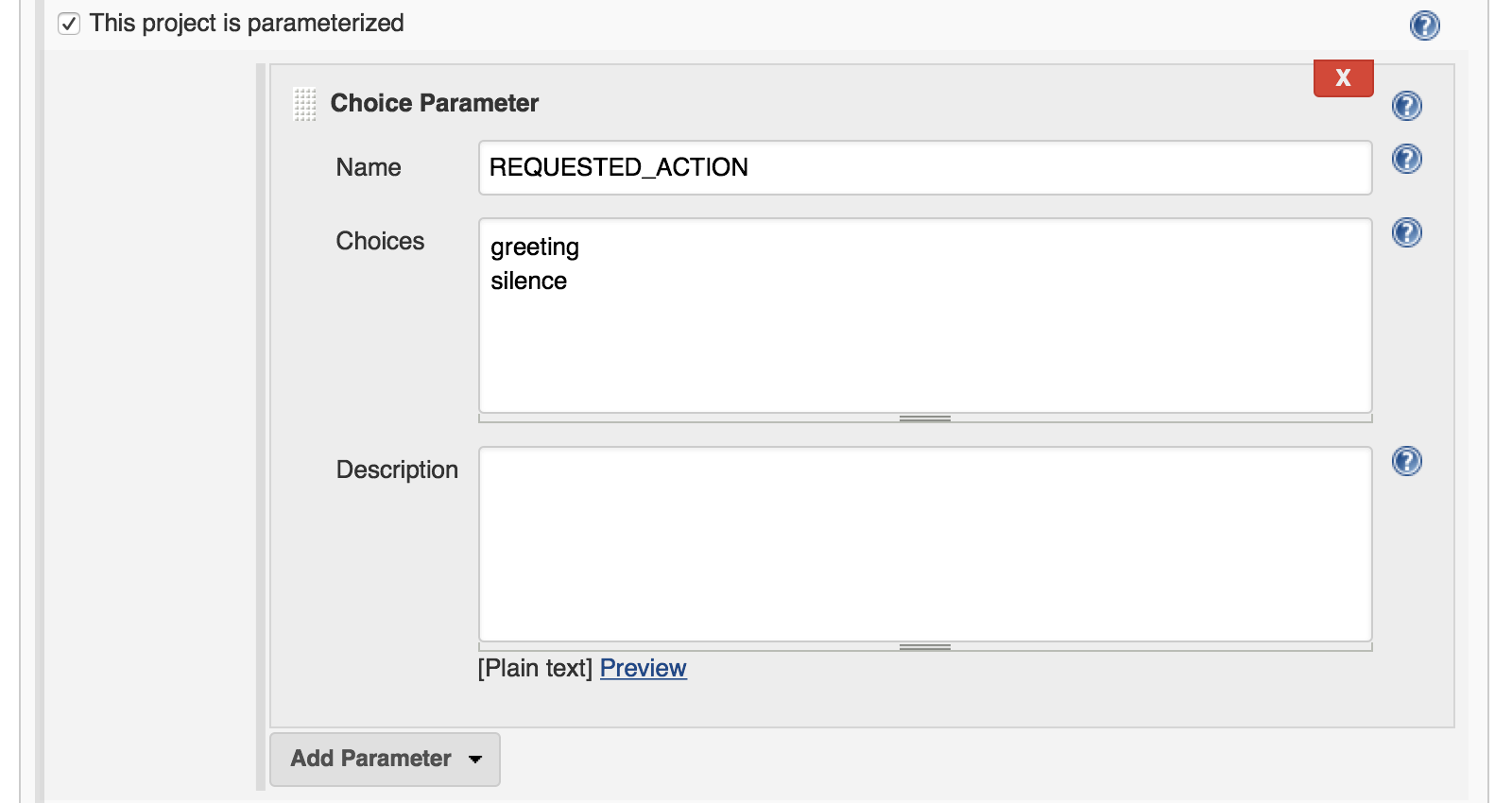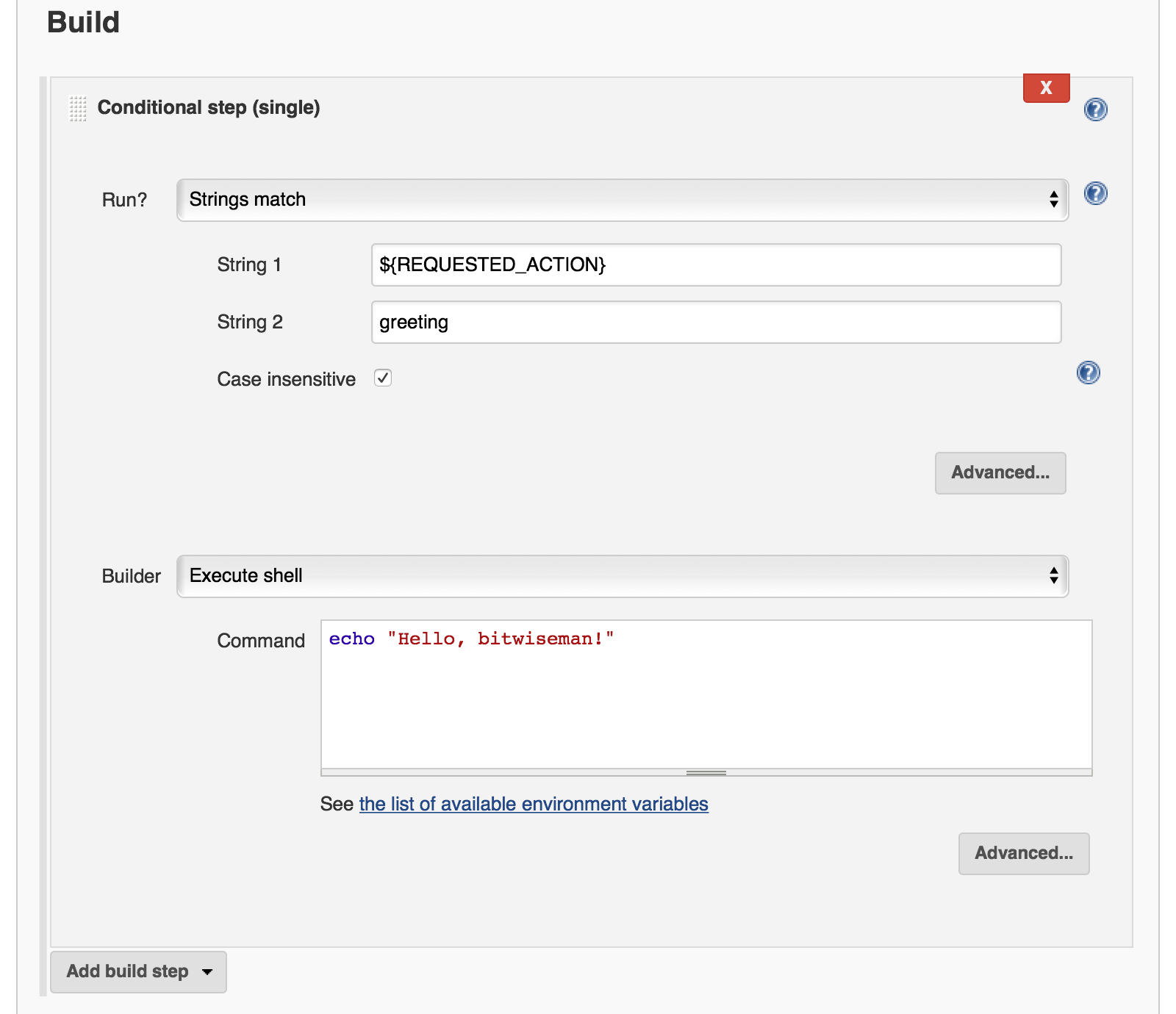| This is a guest post by Liam Newman, Technical Evangelist at CloudBees. |
Introduction
With all the new developments in Jenkins Pipeline (and Declarative Pipeline on the horizon), it’s easy to forget what we did to create "pipelines" before Pipeline. There are number of plugins, some that have been around since the very beginning, that enable users to create "pipelines" in Jenkins. For example, basic job chaining worked well in many cases, and the Parameterized Trigger plugin made chaining more flexible. However, creating chained jobs with conditional behavior was still one of the harder things to do in Jenkins.
The Conditional BuildStep plugin is a powerful tool that has allowed Jenkins users to write Jenkins jobs with complex conditional logic. In this post, we’ll take a look at how we might converting Freestyle jobs that include conditional build steps to Jenkins Pipeline. Unlike Freestyle jobs, implementing conditional operations in Jenkins Pipeline is trivial, but matching the behavior of complex conditional build steps will require a bit more care.
Graphical Programming
The Conditional BuildStep plugin lets users add conditional logic to Freestyle jobs from within the Jenkins web UI. It does this by:
-
Adding two types of Conditional BuildStep ("Single" and "Multiple") - these build steps contain one or more other build steps to be run when the configured condition is met
-
Adding a set of Condition operations - these control whether the Conditional BuildStep execute the contained step(s)
-
Leveraging the Token Macro facility - these provide values to the Conditions for evaluation
In the example below, this project will run the shell script step when the value of the
REQUESTED_ACTION token equals "greeting".


Here’s the output when I run this project with REQUESTED_ACTION set to "greeting":
Run condition [Strings match] enabling prebuild for step [Execute shell]
Strings match run condition: string 1=[greeting], string 2=[greeting]
Run condition [Strings match] enabling perform for step [Execute shell]
[freestyle-conditional] $ /bin/sh -xe /var/folders/hp/f7yc_mwj2tq1hmbv_5n10v2c0000gn/T/hudson5963233933358491209.sh
+ echo 'Hello, bitwiseman!'
Hello, bitwiseman!
Finished: SUCCESSAnd when I pass the value "silence":
Run condition [Strings match] enabling prebuild for step [Execute shell]
Strings match run condition: string 1=[silence], string 2=[greeting]
Run condition [Strings match] preventing perform for step [Execute shell]
Finished: SUCCESSThis is a simple example but the conditional step can contain any regular build step. When combined with other plugins, it can control whether to send notifications, gather data from other sources, wait for user feedback, or call other projects.
The Conditional BuildStep plugin does a great job of leveraging strengths of the Jenkins web UI, Freestyle jobs, and UI-based programming, but it is also hampered by their limitations. The Jenkins web UI can be clunky and confusing at times. Like the steps in any Freestyle job, these conditional steps are only stored and viewable in Jenkins. They are not versioned with other product or build code and can’t be code reviewed. Like any number of UI-based programming tools, it has to make trade-offs between clarity and flexibility: more options or clearer presentation. There’s only so much space on the screen.
Converting to Pipeline
Jenkins Pipeline, on the other hand, enables users to implement their pipeline as code. Pipeline code can be written directly in the Jenkins Web UI or in any text editor. It is a full-featured programming language, which gives users access to much broader set of conditional statements without the restrictions of UI-based programming.
So, taking the example above, the Pipeline equivalent is:
pipeline {
agent any
parameters {
choice(
choices: ['greeting' , 'silence'],
description: '',
name: 'REQUESTED_ACTION')
}
stages {
stage ('Speak') {
when {
// Only say hello if a "greeting" is requested
expression { params.REQUESTED_ACTION == 'greeting' }
}
steps {
echo "Hello, bitwiseman!"
}
}
}
}When I run this project with REQUESTED_ACTION set to "greeting", here’s the output:
[Pipeline] node
Running on osx_mbp in /Users/bitwiseman/jenkins/agents/osx_mbp/workspace/pipeline-conditional
[Pipeline] {
[Pipeline] stage
[Pipeline] { (Speak)
[Pipeline] echo
Hello, bitwiseman!
[Pipeline] }
[Pipeline] // stage
[Pipeline] }
[Pipeline] // node
[Pipeline] End of Pipeline
Finished: SUCCESSWhen I pass the value "silence", the only change is "Hello, bitwiseman!" is not printed.
Some might argue that the Pipeline code is a bit harder to understand on first reading.
Others would say the UI is just as confusing if not more so.
Either way, the Pipeline representation is considerably more compact than the Jenkins UI presentation.
Pipeline also lets us add helpful comments, which we can’t do in the Freestyle UI.
And we can easily put this Pipeline in a Jenkinsfile to be code-reviewed, checked-in, and versioned
along with the rest of our code.
Conditions
The previous example showed the "Strings match" condition and its Pipeline equivalent. Let’s look at couple more interesting conditions and their Jenkins Pipeline equivalents.
Boolean condition
You might think that a boolean condition would be the simplest condition, but it isn’t.
Since it works with string values from tokens, the Conditional BuildStep plugin offers
a number of ways to indicate true or false.
Truth is a case insensitive match of one of the following:
1 (the number one), Y, YES, T, TRUE, ON or RUN.
Pipeline can duplicate these, but depending on the scenario we might consider whether a simpler expression would suffice.
when {
// case insensitive regular expression for truthy values
expression { return token ==~ /(?i)(Y|YES|T|TRUE|ON|RUN)/ }
}
steps {
/* step */
}Logical "OR" of conditions
This condition wraps other conditions.
It takes their results as inputs and performs a logical "or" of the results.
The AND and NOT conditions do the same, performing their respective operations.
when {
// A or B
expression { return A || B }
}
steps {
/* step */
}Tokens
Tokens can be considerably more work than conditions. There are more of them and they cover a much broader range of behaviors. The previous example showed one of the simpler cases, accessing a build parameter, where the token has a direct equivalent in Pipeline. However, many tokens don’t have direct equivalents, some take a parameters (adding to their complexity), and some provide information that is simply not exposed in Pipeline yet. So, determining how to migrate tokens needs to be done on case-by-case basis.
Let’s look at a few examples.
"FILE" token
Expands to the contents of a file. The file path is relative to the build workspace root.
${FILE,path="PATH"}
This token maps directly to the readFile step.
The only difference is the file path for readFile is relative to the
current working directory on the agent, but that is the workspace root by default.
No problem.
when {
expression { return readFile('pom.xml').contains('mycomponent') }
}
steps {
/* step */
}GIT_BRANCH
Expands to the name of the branch that was built.
Parameters (descriptions omitted): all, fullName.
This information may or may not be exposed in Pipeline. If you’re using the
Pipeline Multibranch plugin
env.BRANCH_NAME will give similar basic information, but doesn’t offer the parameters.
There are also
several
issues
filed around GIT_* tokens in Pipeline.
Until they are addressed fully, we can follow the pattern shown in
pipeline-examples,
executing a shell to get the information we need.
GIT_BRANCH = sh(returnStdout: true, script: 'git rev-parse --abbrev-ref HEAD').trim()CHANGES_SINCE_LAST_SUCCESS
Displays the changes since the last successful build.
Parameters (descriptions omitted): reverse, format, changesFormat, showPaths, pathFormat, showDependencies, dateFormat, regex, replace, default.
Not only is the information provided by this token not exposed in Pipeline, the token has ten optional parameters, including format strings and regular expression searches. There are a number of ways we might get similar information in Pipeline. Each have their own particular limitations and ways they differ from the token output. Then we’ll need to consider how each of the parameters changes the output. If nothing else, translating this token is clearly beyond the scope of this post.
Slightly More Complex Example
Let’s do one more example that shows some of these conditions and tokens.
This time we’ll perform different build steps depending on what branch we’re building.
We’ll take two build parameters: BRANCH_PATTERN and FORCE_FULL_BUILD.
Based on BRANCH_PATTERN, we’ll checkout a repository.
If we’re building on the master branch or the user checked FORCE_FULL_BUILD,
we’ll call three other builds in parallel
(full-build-linux, full-build-mac, and full-build-windows),
wait for them to finish, and report the result.
If we’re not building on the master branch and the user did not check FORCE_FULL_BUILD,
we’ll print a message saying we skipped the full builds.
Freestyle
Here’s the configuration for Freestyle version. (It’s pretty long. Feel free to skip down to the Pipeline version):
|
The Pipeline version of this job determines the Freestyle version of this job does not require a local branch, |

Pipeline
Here’s the equivalent Pipeline:
|
Freestyle version of this job is not stored in source control. In general, the Pipeline version of this job would be stored in source control,
would |
pipeline {
agent any
parameters {
string (
defaultValue: '*',
description: '',
name : 'BRANCH_PATTERN')
booleanParam (
defaultValue: false,
description: '',
name : 'FORCE_FULL_BUILD')
}
stages {
stage ('Prepare') {
steps {
checkout([$class: 'GitSCM',
branches: [[name: "origin/${BRANCH_PATTERN}"]],
doGenerateSubmoduleConfigurations: false,
extensions: [[$class: 'LocalBranch']],
submoduleCfg: [],
userRemoteConfigs: [[
credentialsId: 'bitwiseman_github',
url: 'https://github.com/bitwiseman/hermann']]])
}
}
stage ('Build') {
when {
expression {
GIT_BRANCH = 'origin/' + sh(returnStdout: true, script: 'git rev-parse --abbrev-ref HEAD').trim()
return GIT_BRANCH == 'origin/master' || params.FORCE_FULL_BUILD
}
}
steps {
// Freestyle build trigger calls a list of jobs
// Pipeline build() step only calls one job
// To run all three jobs in parallel, we use "parallel" step
// https://jenkins.io/doc/pipeline/examples/#jobs-in-parallel
parallel (
linux: {
build job: 'full-build-linux', parameters: [string(name: 'GIT_BRANCH_NAME', value: GIT_BRANCH)]
},
mac: {
build job: 'full-build-mac', parameters: [string(name: 'GIT_BRANCH_NAME', value: GIT_BRANCH)]
},
windows: {
build job: 'full-build-windows', parameters: [string(name: 'GIT_BRANCH_NAME', value: GIT_BRANCH)]
},
failFast: false)
}
}
stage ('Build Skipped') {
when {
expression {
GIT_BRANCH = 'origin/' + sh(returnStdout: true, script: 'git rev-parse --abbrev-ref HEAD').trim()
return !(GIT_BRANCH == 'origin/master' || params.FORCE_FULL_BUILD)
}
}
steps {
echo 'Skipped full build.'
}
}
}
}Conclusion
As I said before, the Conditional BuildStep plugin is great. It provides a clear, easy to understand way to add conditional logic to any Freestyle job. Before Pipeline, it was one of the few plugins to do this and it remains one of the most popular plugins. Now that we have Pipeline, we can implement conditional logic directly in code.
This is blog post discussed how to approach converting conditional build steps to Pipeline and showed a couple concrete examples. Overall, I’m pleased with the results so far. I found scenarios which could not easily be migrated to Pipeline, but even those are only more difficult, rather than impossible.
The next thing to do is add a section to the Jenkins Handbook documenting the Pipeline equivalent of all of the Conditions and the most commonly used Tokens. Look for it soon!